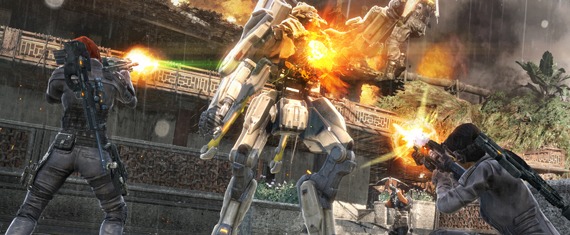 Insomniac Games has expanded well beyond the Ratchet & Clank franchise during this console generation, beginning with the PS3’s Resistance: Fall of Man and continuing with their newest game, Fuse. Published by EA, Fuse marks Insomniac’s most public multiplatform escapade, shipping on Xbox 360 in addition to the developer’s traditional PlayStation home. But even with several consoles to call its own, Fuse is grounded in the basic hallmark of Insomniac’s games: surprisingly deep gunplay. As with many shooters today, the gameplay is only as diverse as players make it. But for those who play Fuse as Insomniac designed it, a uniquely rewarding experience awaits.
Insomniac Games has expanded well beyond the Ratchet & Clank franchise during this console generation, beginning with the PS3’s Resistance: Fall of Man and continuing with their newest game, Fuse. Published by EA, Fuse marks Insomniac’s most public multiplatform escapade, shipping on Xbox 360 in addition to the developer’s traditional PlayStation home. But even with several consoles to call its own, Fuse is grounded in the basic hallmark of Insomniac’s games: surprisingly deep gunplay. As with many shooters today, the gameplay is only as diverse as players make it. But for those who play Fuse as Insomniac designed it, a uniquely rewarding experience awaits.
The Fuse name is a double entendre, referring both to the name of an alien substance that powers the game’s super weapons as well as to what four-person squad does (“fuse” or “gel”) by the end of the campaign. The alien substance of Fuse has been kept by the government since a UFO crash in the 1940s, and it’s since been weaponized to create an unparalleled arsenal. Well, a paramilitary organization named Raven has stolen Fuse with the intention of achieving nothing short of world domination. Players assume the role of a four-person mercenary group that tracks the stolen Fuse around the globe and tries to stop Armageddon. Since you’re doing the government a favor, you also get Fuse-powered weapons, which is where the gunplay elements come in.
Each character fills a traditional role: Dalton is the tank, Naya is a stealthy scout, Jacob is a long-distance sniper, and Izzy assumes the role of the medic. Players can hot-swap between characters immediately and at any time by a simple button press, as long as that character isn’t being controlled by another real-life player. But it’s how those roles are carried out that really shows the magic Insomniac touch.
Dalton, the bruiser, defaults to a heavy rifle with an alt-fire mode that creates a bullet-absorbing “Magsield” for cover. By accumulating points and cash, players can unlock certain parts of Dalton’s skill tree to activate yet another alt-fire mode that lets Dalton actually drop the shield for deployable cover. Naya, meanwhile, is only a stealthy scout when she activates her alt-fire “cloaking” mode, while her primary use of the Warp Rifle is to create anti-matter singularities that rip enemies apart. Jacob, on the other hand, has a nice Arc Shot sniper rifle that can be upgraded over time to create timed charges. And Izzy’s Shattergun may crystalize enemies to buy the team some time, but once she’s upgraded her alt-fire mode allows her to fire healing beacons into her field of view and act like a medic.

Fuse is a co-op shooter in the purest sense of the word, with a four-player squad that really relies on one another’s skills from the midway point of the game onward. Not only does each character have unique gunplay via upgrades and alt-fire modes, but the practical ways gamers play cooperatively shows some impressive depth as well. Many shooters end up having players compete for resources (ammo, loot, etc.) even if they’re supposed to be playing a cooperative game. In Fuse, the gunplay really is cooperative, with points actually being awarded in a way that rewards playing together.
Say Dalton raises his Magshield to protect himself and his squad. He’ll get XP for doing this, but if a teammate shoots enemies through the shield, both Dalton and his cohort will earn XP for the cover/kill cooperation. Or, maybe Izzy will crystallize some enemies to buy herself a breather. If one of her teammates (NPC or not) shatters those foes with traditional gunfire, both Izzy and that squadmate will earn XP.
What’s nice about this “joint XP” concept is that it really motivates players to strategically think through a given situation and identify the best tactics to move on. Remember the Rainbow Six series — before it got totally commercialized and didn’t focus as much on tactical combat? Fuse feels a lot like that, sort of the thinking man’s shooter, providing a good challenge as well as an interesting gunplay experience.
The Fuse plot isn’t nearly as interesting as the gunplay, although you can tell Insomniac made an effort. Each of the characters’ backstory is gradually revealed throughout the campaign, but none of the plot points really resonates. The backstories almost unfold like “aha” moments rather than carefully paced elements that unfold over time. As a result, you never really develop an emotional connection to any of the characters, which makes their grand reveals just fall flat. If you cared a bit more about Dalton as a person, for instance, maybe you’d care about his failed love life a bit more. But you don’t.
Plot failings aside, Fuse provides a rewarding experience whether you play in single- or multiplayer mode. The NPCs have good enough AI so as to actually be helpful, but not so good that it keeps you from feeling like a hero. The graphics are generally good, although the environments look better than the characters, and the lack of diverse enemy types gets old. My biggest complaint is actually that Fuse relies on a ridiculous number of “pry open the door” cinematics that interrupt the flow and end up being downright comical because they happen so frequently. Fortunately, the gameplay situations between those doors is a blast. Fuse has enough depth in gunplay and RPG-like upgrades to intrigue even the most jaded fans of third-person shooters. Insomniac has once again lit the Fuse on inspired, exciting and innovative gunplay. This time, the game even tells you in its name.
Check the latest prices for Fuse at Amazon: Fuse for Xbox 360 | Fuse for PS3
.
Score: 8.8
Platform reviewed: Xbox 360
